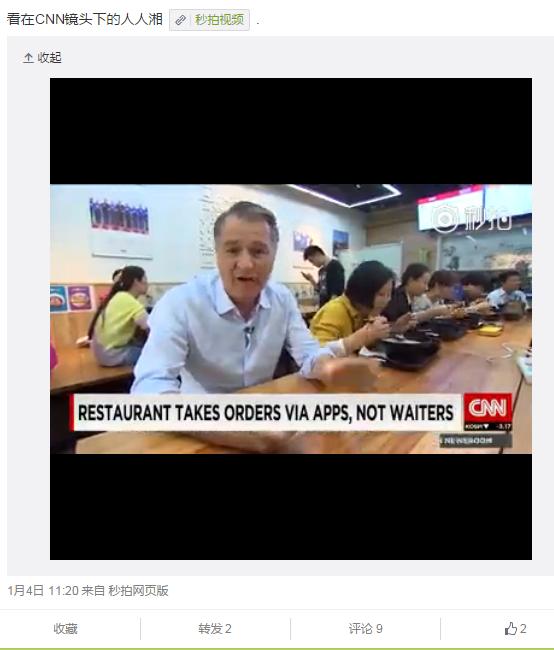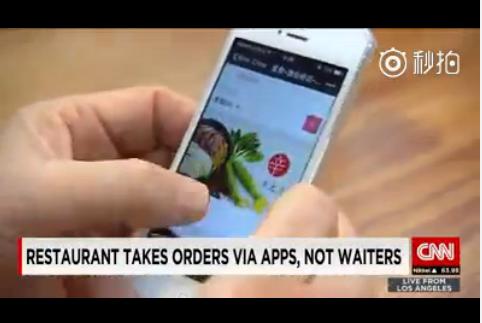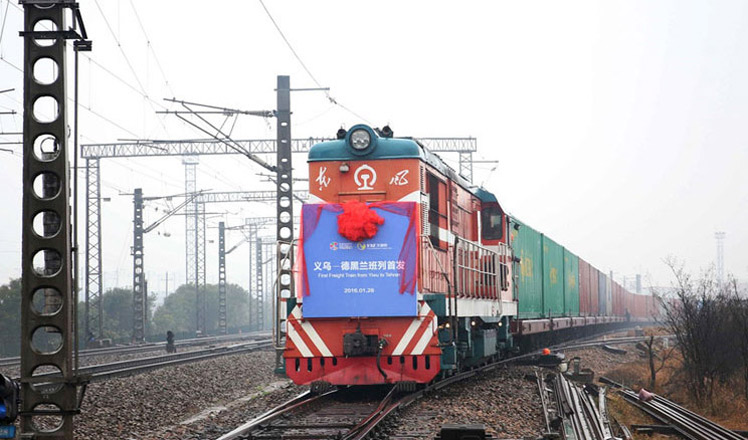Fad or future? Waiterless restaurants come to China
Updated: 2016-02-01 13:39
(Ecns.cn)
|
||||||||
 |
|
Renrenxiang, a waiterless noodle restaurant, published a clip of CNN's report on itself on its official social media account on Sina Weibo,on Jan 4. Photo from Renrenxiang's Weibo. |
 |
| CNN's anchor person shows how to order food on apps, at Renrenxiang.Photo from Weibo. |
For people around the world, dining out follows a similar pattern: Arrive, queue, wait to order, eat and then pay. One Chinese restaurant, however, has ripped up the rule book, and in doing so might just change the way people eat out forever.
While many restaurants go to great lengths to create a certain ambience or plate up food so that it looks more like art than a meal, noodle restaurant Renrenxiang, in Beijing's downtown Guomao, has made a name for itself by doing something all-together different.
The first thing customers notice when they arrive at the noodle restaurant is that there is something missing. While it is customary that waiters greet customers at the door and show them to a table, there is no one to do this at Renrenxiang. In fact, there are no waitstaff at all.
In place of hosts, waiters and cashiers, there is something a lot more 21st century -- a phone app. The only place with human activity is the kitchen where chefs turn digital orders into dishes.
The restaurant's app runs on WeChat, China's most popular online messaging app.
Diners order and pay with the app, wait for their number to be called and then take their own food from the counter. After eating, they deposit their crockery on a cleaning table.
Moreover, customers don't even have to be in the restaurant to order. One frequent diner, Miss Wang, who works nearby, says she orders while still in the office and takes a leisurely stroll down to the restaurant. By the time she arrives, her food is ready and she can enjoy it immediately. "It's very convenient," she says.
 |
|
Liu Zheng, left, CEO of Renrenxiang. [Photo from the restaurant's its official website.] |
Liu Zheng, CEO of Renrenxiang, is proud and optimistic about this system as it reflects the popular online-to-offline service trend gripping China currently. It makes his business more efficient and saves him money as he has less wages to fork out for.
"Opening a restaurant has a huge outlay: Rent, decoration, salaries, the list goes on. Thanks to the rise of the app we can cut out unnecessary expenditure, simplify management and focus more on taste and quality," Liu says.
The app also collects customer-related data -- what dish is the most poplar, and what age groups visit more frequently. Renrenxiang uses the data to improve its marketing strategy.
Liu says he plans to further automate the process to achieve the "Four No's" -- no waitstaff, no cashier, no purchaser and no chef.
Renrenxiang is not the first restaurant to offer waiterless service. As early as in 2007, a restaurant in Nuremberg, Germany, began to offer fully automated order and table services. There are also places in Japan and the United States.
Though a waiterless restaurant is still a novelty, automation is already part of many restaurants. More and more now allow customers to make reservations online, order through touch-screens and pay by mobile payment services.
Using robots, instead of humans, to cook, serve and clean has also become more common in China this year.
- Students must learn safety education, experts say
- 73 bodies recovered from rubble of Shenzhen landslide
- Chinese travelers lead 2015 global outbound tourism
- S Korea to issue 10-year visa to highly-educated Chinese tourists
- A glimpse of Spring Rush: little migrant birds on the way home
- Policy puts focus on genuine artistic students
- Negotiating political transition in Syria 'possible': Hollande
- At least three killed in light plane crashes in Australia
- BOJ further eases monetary policy, delays inflation target
- DPRK may have tested components of hydrogen bomb
- Goodwill sets tone at Wang, Kerry's briefing
- Obama picks new Afghan commander

 Year of the Monkey arriving in Washington
Year of the Monkey arriving in Washington
 Djokovic puts down Federer fightback to reach final
Djokovic puts down Federer fightback to reach final
 Treasures from Romania shine in Beijing museum
Treasures from Romania shine in Beijing museum
 First container train links China to Middle East
First container train links China to Middle East
 'Monkey King' performs dragon dance in underwater tunnel in Tianjin
'Monkey King' performs dragon dance in underwater tunnel in Tianjin
 The odd but interesting life of a panda breeder
The odd but interesting life of a panda breeder
 Top 10 best selling cars on Chinese mainland 2015
Top 10 best selling cars on Chinese mainland 2015
 Warm memories in the cold winter
Warm memories in the cold winter
Most Viewed
Editor's Picks

|

|

|

|

|

|
Today's Top News
National Art Museum showing 400 puppets in new exhibition
Finest Chinese porcelains expected to fetch over $28 million
Monkey portraits by Chinese ink painting masters
Beijing's movie fans in for new experience
Obama to deliver final State of the Union speech
Shooting rampage at US social services agency leaves 14 dead
Chinese bargain hunters are changing the retail game
Chinese president arrives in Turkey for G20 summit
US Weekly

|

|








